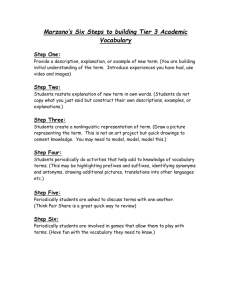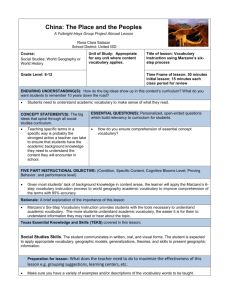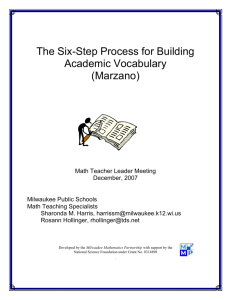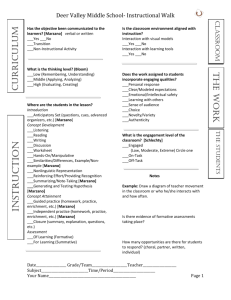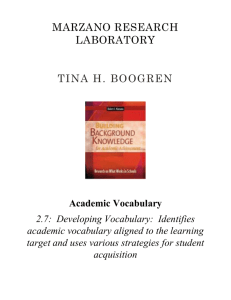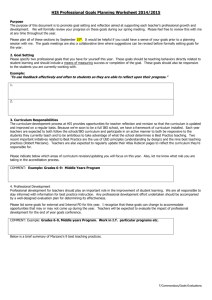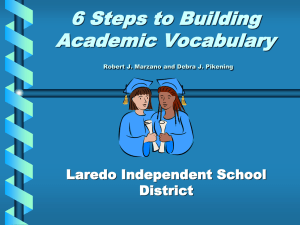A Systematic Vocabulary Development Instructional Focus
advertisement
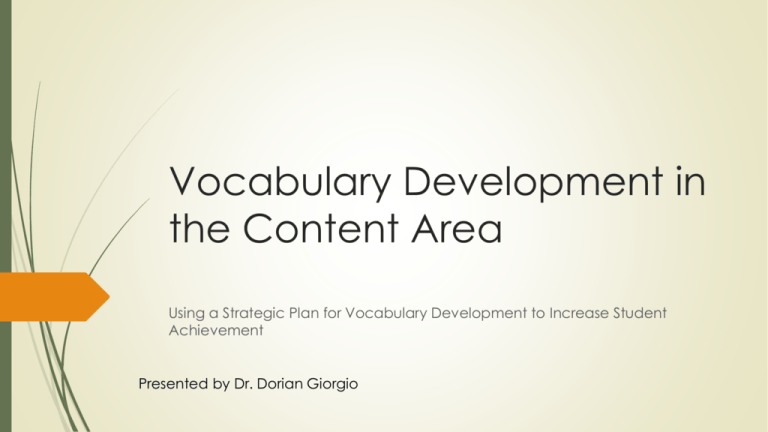
Vocabulary Development in the Content Area Using a Strategic Plan for Vocabulary Development to Increase Student Achievement Presented by Dr. Dorian Giorgio Ice Breaker Using the laminated cards and tacky create a poster that shows how you teach math vocabulary with your class Pick a partner to share Note what you have in common Did you use all the same cards? Share with your table. Agenda Research Review – Why Focus on Vocabulary? How Does the Brain Learn and Remember Vocabulary? Types of Vocabulary Marzano’s 6-Step Process for Developing Vocabulary Designing a Strategic Plan for Vocabulary Development in 2015-2016 Share Out 4 Why? Comprehensive School Focus Powerful District Message 5 By the end of the session You will: Understand the characteristics of effective vocabulary instruction, and Apply a six-step process for direct instruction in vocabulary. Vocabulary Development Research Marzano and Sims (2013) Children from low economic families develop less working vocabulary Children from higher SES homes have more language-learning experiences Language development gap increases over time Children develop vocabulary by socializing with important people in their lives Three Areas Affected by Low Vocabulary Development Marzano and Sims (2013) Reading Ability Independent Reading Mental Processes Types of Vocabulary Tier 1 words Developed through conversation, reading and daily experiences May need support for ELL students and students from low SES environment Tier 2 words General academic or literary words Need to be developed as they are encountered and during vocabulary lessons Tier 3 words Domain specific words Must be systematically developed during content instruction Process of Vocabulary Development Adapted from Marzano and Sims (2013) New Even a little time spent on vocabulary development can enrich learners! Process of Vocabulary Development Adapted from Marzano and Sims (2013) Familiar Process of Vocabulary Development Adapted from Marzano and Sims (2013) Assimilation Process of Vocabulary Development Adapted from Marzano and Sims (2013) Fluent Step 1 The teacher provides a description, explanation, or example of the new term Discussion Starters for Types of Word Types People (author, character, villain, narrator, guest speaker, host, hostess, film director, political cartoonist) Events (play, interview, simulation, chance event) Key Feature Questions What actions does this kind of person perform? What is required to become this kind of person? What physical or psychological characteristics does this kind of person have? What people are associated with this kind of event? What process or actions are associated with this kind of event? What equipment, materials, resources, or contexts are associated with this kind of event? What setting is associated with this kind of event? What causes and consequences are associated with this kind of event? What process is associated with this kind of product? What purpose is associated with this kind of product? What people is associated with this kind of product? What equipment is associated with this kind of product? What process is associated with this kind of mental action? What people are associated with this kind of mental action? What location is associated with this kind of mental action? What causes or consequences are associated with this kind of mental action? What purpose is associated with this kind of group, institution, or organization? What people are associated with this kind of group, institution, or organization? What setting is associated with this kind of group, institution, or organization? Intellectual, artistic, or cognitive products (essay, argument, tessellation, proof, model) Mental actions (revise, edit, reflect, problem solve, prove) Social/societal groups, institutions, or organizations (audience, Modern Language Association, American Psychological Association, control group, representative, sample population) Shapes/direction/position (order of events, introduction, conclusion, polygon, coordinate plane, circumference, data distribution) Quantities/amounts/measurements (time frame, pacing, Roman numeral, cardinal number, greater than, function) What physical features are associated with this kind of shape, direction, or position? What uses are associated with this kind of shape, direction, or position? What reference points are associated with this kind of shape, direction, or position? What relationships are associated with this kind of quantity, amount or measurement? What referents are associated with this kind of quantity, amount or Step 2 Ask students to restate the description, explanation, or example in their own words How we Remember Logogens use words Imagens use pictures Logogens and Imagens combine to provide meaning Sights, sounds, smells, and emotions provide stimulus to remember what we learn Students need to engage is social learning experiences to create these memories Step 3 Ask students to construct a picture, symbol, or graphic representing the word. Vocabulary Notebooks Provide learning activities for students to explore new terms Provide student choice in representing new terms Combine steps 2 and 3 in one activity Provide an opportunity to share and reflect with classmates Provide students with a reference material for use during mathematics Complete One Vocabulary Organizer Pick one vocabulary organizer Pick a term from “horizontal”, “square” or “thousand” Write a definition for the term in your own words on the organizer. Create an image to represent the term on the organizer. Step 4 Engage students periodically in activities that help them add to their knowledge of the terms in their vocabulary notebooks Choose two words from word list and complete a Connect Two. Line Line Segment Point Polygon Vertex Two-Dimensional Three-Dimensional Length Width Perimeter Closed Figure Area Plane Figure Angle Rectangle Right Angle Square Ray Circle Choose one word and complete the Examples and Non-examples Organizer Line Line Segment Point Polygon Vertex Perimeter Area Angle Right Angle Ray Two-Dimensional Three-Dimensional Length Width Closed Figure Plane Figure Rectangle Square Circle Step 5 Periodically ask students to discuss the terms with one another Discourse Time Taken from Discourse Time! Developing the Argumentative Literacy in the Math Classroom by David Singer (2007) Small group discussion used to solve a problem while an outside group of equal size monitors and scores Problem should not necessarily have a clear right or wrong answer Problem should not be given to students to solve on their own Problem should include previously taught vocabulary terms Students use their vocabulary notebooks to support their thinking Use a set scoring system Sit scorers outside the group and across from the person they are scoring Discourse Time Scoring Suggestions State an opinion relevant to the problem (1 point) Draws another person into the discussion (1 point) Makes a connection – does not need to be math based (1 point) Supports an opinion with factual evidence (1 point) Asks a question that moves the discussion – pushes the group’s thinking (2 points) Proves some else's opinion with evidence (2 points) Uses term from vocabulary notebook correctly (2 points) Takes away from value of D. T. (-1 point) Sample Discourse Problem In a two-boat sailing race, one boat, Windsprite, rounds the final buoy and sails straight for the finish line at 12.0 knots. Exactly 4 minutes after Windsprite rounds the final buoy, the other boat, Porpoise, reaches that point and heads for the finish line at 12.7 knots. Windsprite reaches the finish line 49 minutes after rounding the last buoy. Who wins the race? Why? Windsprite Porpoise Discourse Time Vocabulary List Sailboat Knot Distance Rate Minutes Difference Step 6 Involve students periodically in games that allow them to play with terms Pictionary Memory Jeopardy Charades Name that Category Bingo 37 Working with ESL Students Step 1 (ESL): Provide a description, explanation, or example of the new term (along with a nonlinguistic representation). Step 2 (ESL): Ask students to restate the description, explanation, or example in their own words in their own language. Step 3 (ESL): Ask students to construct a picture, symbol or graphic representing the term or phrase. Students should create their own representation and not copy yours from Step 1. 38 Working with ESL Students Step 4 (ESL): Engage students periodically in activities that help them add to their knowledge of the terms in their notebook. Allow students to use their native language as much as possible. Step 5 (ESL): Periodically ask students to discuss the terms with one another. Pair students of the same language together. Step 6 (ESL): Involve students periodically in games that allow them to play with terms. Pair students of the same language together. Using a Word Wall taken from https://www.choiceliteracy.com/articles-detail-view.php?id=1329 Add three to five high frequency words each week Introduce them with fanfare Have a brief, whole-group word wall activity every day Use an area of the classroom where the students can see the words and may be working on activities that engage those words Don’t forget to have a “retirement party” for words that the students have mastered, and remove mastered words Vocabulary for Common Core Standards Word Wall cards arranged by grade level found at http://www.ncesd.org/Page/983 40 Create a strategic plan Develop a list of terms 1, 2, 3 terms per week for 30 weeks to teach target terms. Develop a weekly or unit plan for when and how each step in the 6 step plan will be included in lessons Encourage students to add information to vocabulary notebooks after working with terms on other learning activities Develop an assessment strategy Must include all 6 Steps 41 Example of Typical Two-Week Period Monday Tuesday Provide schema for new term. Students will discuss and write understanding. (Steps 1-2) Wednesday Thursday Friday Vocabulary Create nonlinguistic game played representation. right before (Step 3) lunch period. (Step 6) Comparison Activity (Step 4) Vocabulary game played at end of day. (Step 6) Monday Tuesday Thursday Friday Provide schema for new term. Students will discuss and write understanding. (Steps 1-2) Vocabulary Create nonlinguistic game played representation. right before (Step 3) lunch. (Step 6) Think-PairShare Activity (Step 5) Comparison Activity (Step 4) Wednesday Lessons Learned – From Kimberly Tyson at http://www.learningunlimitedllc.com/2012/12/marzanos-6-step-vocabulary-process/ As a teacher, you can’t teach every word which is why students also need to be engaged in independent reading to build their vocabulary. However, for targeted words that are key to mastering content or comprehending text, you should try implementing the six-step process. Since Marzano’s six-step process has been around a number of years, he reports several “lessons learned.” Keep these in mind as you implement the six-step process: The process works best when you don’t skip any steps. Don’t pick and choose which step you “like” best – do all 6 steps. Students need to generate their own definition of a term – sometimes I call this a “kid friendly” definition. Step 3 – the nonlinguistic definition – is a powerful and important step. When students visualize, create a pictogram, or act out a word, they learn it well and achievement soars. Games – Step 6 – help students play with words and internalize word meanings in a non-threatening atmosphere. Your 6 Step Strategic Plan Use the planning tools in your handout to work with your colleagues to develop your classroom plan. Determine when/how for each unit of instruction you will complete each of the 6 steps Will you need a weekly schedule? Will you add mathematical terms to other vocabulary instruction? Will you use a vocabulary notebook that includes all vocabulary or design one just for mathematics? What will be the layout for the notebook? What assessment strategies will you use and how can they be used formatively? Marzano’s 6-Step Process for Vocabulary Instruction Step 1 – Describe – Provide students with a description, explanation or example (not a definition) using common language • Determine prior knowledge • What do you think you know about this term? • Use imagery Step 2 – Restate – Students restate the description, explanation or example in their own words • Discuss with a partner • Student record (notebook or journal) Step 3 – Representations - Students represent the term non-linguistically • Graphic representation illustrating process • Draw the thing • Draw a symbol • Dramatize the term • Student record (notebook or journal) Step 4 – Activities – Engage students periodically in activities that add to their knowledge of the terms • Identify synonyms or antonyms • List related words • Write reminders of common confusions • Draw an additional graphic • Write metaphors and analogies • Compare terms • Classify terms • Student record (notebook or journal) Step 5 – Discuss – Ask students to discuss terms with each other • Think-Pair-Share about targeted terms • 2 minute vocabulary BUZZ • Add to or revise student record (notebook or journal) Step 6 – Games - Play games with your terms • Jeopardy • Pyramid • I have, who has? Marzano (2004) Thank you! Have a great year.
